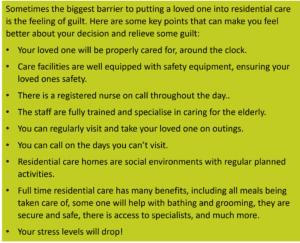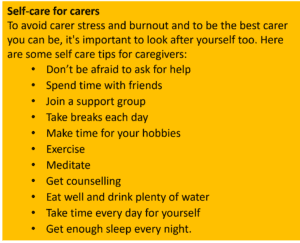Being a Carer, when you can no longer provide care for your Loved one.
being a carer can be a difficult role. When you can no longer provide care for their elderly loved one, there are two main choices to consider. You can get help with care in your own home or you can put your loved one into residential care.
In-home care
There are many organisations that provide services for in home care. Home care support workers can help with caring tasks such as bathing, dressing, mobility, meals, toileting and more. They may come to your home every day or when required.
A home care support worker can often help you and the person you care for to stay in your home longer. However, sometimes your loved one may need more care than they (and you, as a carer) can provide at home.
Residential care
Depending on your loved ones condition, various types of residential care may be available for them to live and be supported:
- Residential aged care can provide accommodation and personal care 24 hours a day as well as access to nursing and health care services for elderly people.
- Residential disability care can provide accommodation and support to people with disability or mental illness.
- Hospice care focuses on quality of life for people who are experiencing an advanced, life limiting illness.
At some stage, while being a carer, you may have to deal with the reality that you can no longer care for your loved one. This may be due to their health needs being beyond your capability, your own health issues or a range of other reasons. No matter what the reason, the difficult decision can be fraught with anguish, guilt and uncertainty.
However, there are ways to make the decision and process smoother and less stressful.
Consider your loved one’s needs
The first step in deciding to put a loved one into care is to consider their needs. Do they require round-the-clock care or just a few hours of help each day? Are they able to manage their own medications, or do they need assistance with this task? Do they have any medical conditions that require specialised care? By understanding your loved one’s needs, you can better assess whether in-home care or a care facility is the best option.
Talk to your loved one
It’s important to involve your loved one in the decision-making process. Have an open and honest conversation with them about their carer needs and how they feel about potentially moving into a care facility. Be sure to listen to their concerns and preferences. They may be resistant to the idea of leaving their home, but it’s important to explain why this may be necessary for their health and well-being.
Research care facilities
If you decide that a care facility is the best option for your loved one, it’s important to research potential options. Look for facilities that meet your loved one’s needs and preferences, such as location, specialised care services, and amenities. Make a list of the top contenders and schedule tours to visit each facility. During the tours, ask as many questions as you can and observe the environment and staff interactions with current residents.
Financial Costs
Residential care facilities can be expensive, so it’s important to discuss financial options with your loved one. This may include using savings or applying for government assistance. Make sure to review all the options and their associated costs to find the best solution.
Take care of yourself
It’s easy to become overwhelmed and stressed when making the decision to put a loved one into care. Remember to take care of yourself and seek help if you need it. This may include taking breaks from being a carer, or delegating caregiving tasks to other family members or professional carers. By taking care of yourself, you’ll be better equipped to make the best decision for your loved one.
Making the decision to put a loved one into care can be challenging, but with careful consideration, research, and communication, it can be easier. Remember to prioritise your loved one’s needs and preferences, and involve them in the decision-making process, along the way and give yourself a break if you need.


“I faced that (the decision to put my wife in care) many years ago and asked people who I thought should know, but I got vague, unhelpful answers.
Finally, I spoke to a lady, over the phone, from Domiciliary Care who gave me an answer which was what I wanted. She gave me three pointers. 1. When you wished they were somewhere else. 2. When the possibility of physical harm could occur. 3. When the carer’s health was affected. I could satisfy all three, and my patience and tolerance was being tested to the limit, despite the ‘patient’ being my lovely wife.
I wondered how to broach the topic to her, but my GP understood and helped. My wife respected our GP and he told her that I was getting very tired, and if she went into respite, I would be helped. She accepted that.
I wondered about the questions such as ‘when can I go home?” and similar. I was armed with the reply “The doctor has said ‘A little longer’”. However, those situations never happened. I was blessed, but I’m sure it doesn’t happen like that for every case.”
Dean, COTA Member


Interested in similar articles? Why not check these out:
Ten tips for retirees….who have become carers
Sources:











